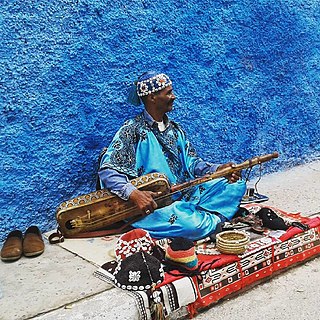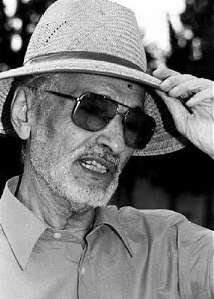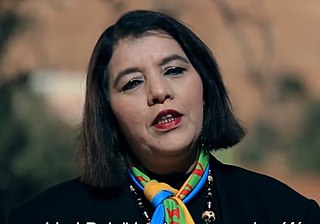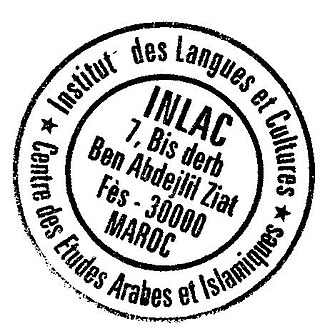
Tifinagh is a script used to write the Berber languages. Tifinagh is descended from the ancient Libyco-Berber alphabet. The traditional Tifinagh, sometimes called Tuareg Tifinagh, is still favored by the Tuareg Berbers of the Sahara desert in southern Algeria, northeastern Mali, northern Niger and northern Burkina Faso for writing the Tuareg Berber language. Neo-Tifinagh is an alphabet developed by Berber Academy to adopt Tuareg Tifinagh for use with Kabyle; it has been since modified for use across North Africa.

Berbers or the Berber peoples, also called by their contemporary self-name Amazigh or Imazighen, are a diverse grouping of distinct ethnic groups indigenous to North Africa who predate the arrival of Arabs in the Arab migrations to the Maghreb. Their main connections are identified by their usage of Berber languages, most of them mutually unintelligible, which are part of the Afroasiatic language family. They are indigenous to the Maghreb region of North Africa, where they live in scattered communities across parts of Morocco, Algeria, Libya, and to a lesser extent Tunisia, Mauritania, northern Mali and northern Niger. Smaller Berber communities are also found in Burkina Faso and Egypt's Siwa Oasis.

Fatema Mernissi was a Moroccan feminist writer and sociologist.

The Gnawa are an ethnic group inhabiting Morocco.

Berberism is a Berber political-cultural movement of ethnic nationalism, started mainly in Kabylia (Algeria) and in Morocco later spreading to the rest of the Berber communities in the Maghreb region of North Africa. The Berberist movement in Algeria and Morocco is in opposition to cultural Arabization, the pan-Arabist political ideology and Islamism.

The culture of Morocco is a blend of Arab, Amazighs, Andalusian cultures, with African, Hebraic and Mediterranean influences. It represents and is shaped by a convergence of influences throughout history. This sphere may include, among others, the fields of personal or collective behaviors, language, customs, knowledge, beliefs, arts, legislation, gastronomy, music, poetry, architecture, etc. While Morocco started to be stably predominantly Sunni Muslim starting from 9th–10th century AD, in the Almoravids empire period, a very significant Andalusian culture was imported and contributed to the shaping of Moroccan culture. Another major influx of Andalusian culture was brought by Andalusians with them following their expulsion from Al-andalus to North Africa after the Reconquista. In antiquity, starting from the second century A.D and up to the seventh, a rural Donatist Christianity was present, along an urban still-in-the-making Roman Catholicism. All of the cultural super strata tend to rely on a multi-millennial aboriginal Berber substratum still strongly present and dating back to prehistoric times.

Mohamed Chafik, born 17 September 1926, is a leading figure in the Amazigh cultural movement. An original author of the Amazigh Manifesto, he was later appointed as the first Rector of the Royal Institute of the Amazigh Culture. He has worked extensively on incorporating Amazigh culture into Moroccan identity and is a leading intellectual of the Moroccan intelligentsia.
The indigenous population of the Maghreb region of North Africa encompass a diverse grouping of several heterogenous ethnic groups who predate the arrival of Arabs in the Arab migration to the Maghreb. They are collectively known as Berbers or Amazigh in English. The native plural form Imazighen is sometimes also used in English. While "Berber" is more widely known among English-speakers, its usage is a subject of debate, due to its historical background as an exonym and present equivalence with the Arabic word for "barbarian." When speaking English, indigenous North Africans typically refer to themselves as "Amazigh."

Central Atlas Tamazight or Atlasic is a Berber language of the Afroasiatic language family spoken by 2.3 million in the Atlas Mountains of Central Morocco as well as by smaller emigrant communities in France and elsewhere.

Fatima Tabaamrant is a Moroccan Berber actress and singer-songwriter. She sings and performs in her native Berber tongue.

Dreams of Trespass: Tales of a Harem Girlhood is a novel by Fatima Mernissi; the UK title has been The Harem Within: Tales of a Moroccan Girlhood. It describes her fictionalised youth in a Moroccan harem during the 1940s and explores the themes of Islamic feminism, Arab nationalism, French colonialism and the clash between the traditional and the modern. It is a fictional work, although this fact is only noted in the French version, not the English.

There are a number of languages in Morocco. De jure, the two official languages are Standard Arabic and Standard Moroccan Berber. Moroccan Arabic is by far the primary spoken vernacular and lingua franca, whereas Berber languages serve as vernaculars for significant portions of the country. The languages of prestige in Morocco are Arabic in its Classical and Modern Standard Forms and sometimes French, the latter of which serves as a second language for approximately 33% of Moroccans. According to a 2000–2002 survey done by Moha Ennaji, author of Multilingualism, Cultural Identity, and Education in Morocco, "there is a general agreement that Standard Arabic, Moroccan Arabic, and Berber are the national languages." Ennaji also concluded "This survey confirms the idea that multilingualism in Morocco is a vivid sociolinguistic phenomenon, which is favored by many people."
Dr. Michael Peyron is a specialist in the field of Berber language, literature and culture. He is also well known as a writer on tourism in Morocco.

Berber orthography is the writing system(s) used to transcribe the Berber languages.
Galila Tamarhanal-Habashiya was a medical practitioner in 19th century Ottoman Egypt. She was one of the earliest women to sign her articles in the Arab press, by contributing "articles to a medical magazine called Yaasoub el-Tib in the 1860s". After completing her studies in 1847 at the nursing school of Abu Zaabal, she was appointed by the latter as an assistant schoolmistress, and was promoted in 1857 to the position of chief instructor, which she held until her death.

The history of women in Morocco includes their lives from before, during, and after the arrival of Islam in the northwestern African country of Morocco.

Moha Ennaji ; is a Moroccan linguist, author, political critic, and civil society activist. He is a university professor in the Department of English Language and Literature at Sidi Mohamed Ben Abdellah University at Fes, where he has worked for over 30 years. In addition to his publications in linguistics, he has written on language, education, migration, politics, and gender, and is the author or editor of over 20 books.

The International Institute for Languages and Cultures, Fès, Morocco (INLAC) is a private institute for teaching and learning Arabic, located in the old city (medina) of Fez. It offers undergraduate and graduate credit programs.
Kalima was a French language monthly women's magazine and news magazine published in Morocco between 1986 and 1989. The magazine was a feminist publication and the first women's magazine in the country.

Jewelleryof the Berber cultures is a historical style of traditional jewellery that was worn by women mainly in rural areas of the Maghreb region in North Africa and inhabited by indigenous Berber people. Following long social and cultural traditions, Berber or other silversmiths in Morocco, Algeria and neighbouring countries created intricate jewellery with distinct regional variations. In many towns and cities, there were Jewish silversmiths, who produced both jewellery in specific Berber styles as well as in other styles, adapting to changing techniques and artistic innovations.















